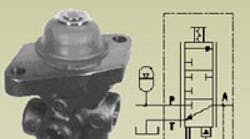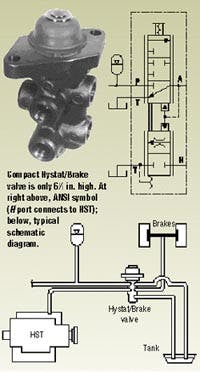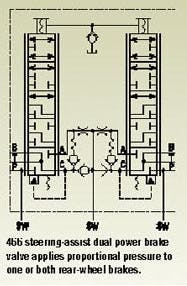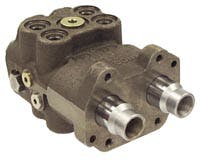Because of the size of much of today's mobile equipment, hydraulic service brakes are a necessity. Engineers at MICO Inc., North Mankato, Minn., add value to the brake components they design by arranging for them to interface and interact with other systems on the equipment.
MICO's Hystat/Brake valve was developed to perform two consecutive functions on mobile equipment driven by hydrostatic transmissions: first to destroke the HST, and then to apply the vehicle service brakes. (Some equipment operators describe this logical combination of functions as inching.) Obviously, less braking effort is needed when the transmission is not driving.
Depending on the equipment design, the brake system may have a dedicated pump or it may be tapped into the main hydraulic system. Typically, an accumulator and charge valve ensure that pressure is available to operate the brakes. Inside the Hystat/Brake housing, two spools are mechanically linked to stroke simultaneously. When the operator depresses the brake pedal, the 2-position proportional spool connected to the HST swashplate control modulates that line to tank, and the pump de-strokes. With the HST in neutral, a pilot system between the spools allows the 3-position proportional spool to move independently - to apply the brakes and slow the vehicle. When the brake pedal lets the valve destroke, the brakes release, and the HST re-engages.
The compact Hystat/Brake valves are fully activated by 310 lb of push-rod force. They produce a maximum brake pressure between 500 and 600 psi. (Higher pressures are available in some optional models). Note that these valves can only be used with mineral-based hydraulic oils.
An arrangement of check valves and orifices between the valve spools ensures that pressure on both brakes will be balanced, even if the operator does not depress both pedals an equal distance. This part of the circuit also prevents loss of fluid if there is a rupture in the brake system. Other benefits include smooth modulation at low pressures, and a pedal feel that accurately represents brake pressure.
The compact, integrated design of the 466 allows it to be adapted into a variety of hydraulic systems and many dual-pedal systems. With additional components, the valve can be used in open-center, closed-center, and load-sensing hydraulic systems on the vehicle, as well as dual-axle brNote that both of the described valves are application specific — so they must be sized very carefully.
Click here to view a technical paper, Brought to a Stop, which describes braking system designs for off-highway vehicles.
Abstract: All mobile equipment needs brakes. Some, however, must also be able to "inch" into postion. Selection of the appropriate type of braking and inching configuration is often determined by the machine class and size.
Call MICO Inc., at (507) 625-6426 or visit www.mico.com.




